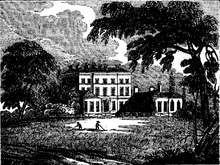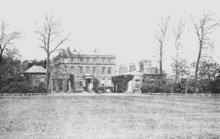Bushy House
| Bushy House | |
|---|---|
 East side of Bushy House in 1992 | |
| General information | |
| Type | House |
| Location | Teddington, London, England |
| Coordinates | 51°25′13″N 0°20′21″W / 51.42028°N 0.33917°WCoordinates: 51°25′13″N 0°20′21″W / 51.42028°N 0.33917°W |
| Construction started | 1663 |
| Renovated | 1713–1715 |
| Client | Edward Proger |
| Owner | Part of National Physical Laboratory |
| Design and construction | |
| Architect | William Samwell |
Bushy House is a Grade II* listed[1] former royal residence in Teddington in South West London, on the site of the National Physical Laboratory, overlooking Bushy Park. Bushy House and 30 acres (120,000 m2) of surrounding Bushy Park land were proposed as a site for the National Physical Laboratory in 1900 after concerns about flooding of the previously proposed site in the Old Deer Park. The ground floor and basement levels of Bushy House were converted to laboratory space and Richard Glazebrook, the first director of NPL, and later other directors, used part of the building as private accommodation.
Today, Bushy House still contains a number of laboratories, two small museums that mainly contain old scientific equipment and several rooms used for meetings and conferences.
History
Bushy House was originally built in 1663 by William Samwell for Edward Proger, at a cost of £4000, as a keeper's lodge in what was at the time North Park. Proger had been made ranger of Bushy Park to reward him for his loyalty to King Charles II during his exile.
It was rebuilt and repaired by Charles Montagu from 1713 to 1715 after he had bought the three parks from the Duchess of Cleveland. The house then passed to Charles' cousin George Montague (1715–1737) and then to George's son George Montague-Dunk (1737–1771). From 1771 to 1792, it was occupied by Lord North the Prime Minister.

In 1797, after the death of both Lord North and his wife, King George III appointed his son, William, Duke of Clarence, as Ranger of Bushy Park, carrying with it residence at Bushy House. The future King William IV and his mistress Dorothy Jordan[2] lived there together with their ten children until the couple's relationship came to an end in 1811. William continued living in Bushy House with the FitzClarence children and later his wife Princess Adelaide after they married in 1818. When at 6am on 26 June 1830 a messenger from London arrived at Bushy House with the news that the King was dead and that William was now king, William is said to have replied that he had 'always wished to sleep with a queen' and gone back to bed. As William had appointed her Ranger in her own right upon his accession, after William's death in 1837, Bushy House became Adelaide's official residence until her death in 1849.
In 1865, Queen Victoria offered Bushy House to the Duc de Nemours and other members of the exiled French royal family as they tried to restore the House of Bourbon. After his return to France in 1871, he kept Bushy House until 1897 in case he was forced to leave France again.
The new National Physical Laboratory was opened at Bushy House by the Prince of Wales (later King George V) in March 1902.[3]
References
- ↑ Historic England. "Bushy House (1080870)". National Heritage List for England. Retrieved 3 August 2015.
- ↑ Google Books The Story of Dorothy Jordan Armstrong, Clare & Jerrold, Bridgman Ayer Publishing, 1969 ISBN 0-405-08672-5, ISBN 978-0-405-08672-4
- ↑ "The National Physical Laboratory". The Times (36720). London. 20 March 1902. p. 6.
Sources

| Wikimedia Commons has media related to Bushy House. |
- Eileen Magnello (2000). A Century of Measurement. Canopus. ISBN 0-9537868-1-1.
- The Story of Bushy House
